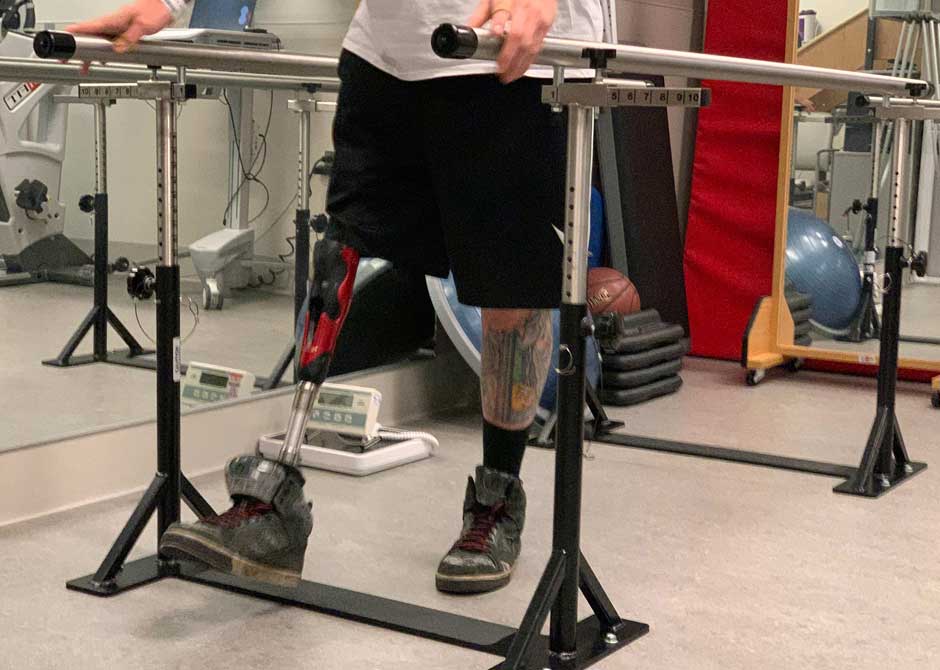
Jennifer Swift, DPT
- Physical Therapist
 Osseointegration surgery is an innovative procedure that can provide better quality of life and improved prosthetic mobility and comfort for people with certain types of amputation.
Osseointegration surgery is an innovative procedure that can provide better quality of life and improved prosthetic mobility and comfort for people with certain types of amputation.
The Ohio State University Wexner Medical Center in Columbus, Ohio, is one of only a few locations in the United States that offers a comprehensive program focused on this pioneering approach to prosthetic attachment. Our surgical team has as much experience with osseointegration care as any in the country. The procedure can change the lives of people who have experienced amputations from combat-related injuries, traumatic accidents and cancer or other diseases.
As a leader in amputation-related care, the Ohio State Wexner Medical Center is home to a multidisciplinary team consisting of plastic surgeons, orthopedic specialists, prosthetic experts, physical rehabilitation providers and others. They’re reimagining prosthetic devices for the hundreds of people with amputations whom they care for every year.
These experts will be by your side through the continuum of care from choosing whether the surgery is right for you to having the procedure and participating in postsurgical rehabilitation.
Osseointegration surgery can help people who have had poor experiences with traditional prostheses as well as give those who haven’t previously been candidates for a prosthetic limb the ability to walk or use their arms again. It’s a two-part procedure that can be done during an amputation or much later to relieve painful complications.
After an amputation, surgeons place a metal implant in the remnant limb. Once the implant bonds with bone tissues over a few months, the doctors perform residual limb optimization to shape the remaining limb for a smooth, tailored fit for the prosthetic device. This anchors the prosthesis into the bone through the metal implant.
Osseointegration creates what Ohio State doctors call the “Luke Skywalker effect,” in that it restores a fluidity of natural movement not previously possible. It improves the fit, stability, comfort and function of the artificial limb.
While osseointegration surgery for prosthetic devices is relatively new, the technique has been used successfully in dental implants for decades.

Stacey’s successful Osseointegration, performed by Jason Souza, MD, has been a gift that allowed her to get back to her passion of caring for, training, and showing horses.
Joel Mayerson, MD, discusses how people with certain types of amputation can benefit from osseointegration.
Osseointegration surgery is for people who have experienced an amputation and either aren’t a candidate for a traditional artificial limb or haven’t experienced the desired results from other prosthetic devices, such as a socket prosthesis.
While osseointegration is most commonly used for above-the-knee amputations, it can also be used on these parts of the body:
Other factors might play a role in whether you’re a candidate for osseointegration. Those include:
Osseointegration techniques can vary, and the surgery can be part of an amputation or done alongside other procedures. Your surgeon will discuss procedure steps during your preoperative visits, but generally, osseointegration requires two procedures followed by a series of physical rehabilitation and follow-up visits.
After working with your physicians to determine if you’re a candidate for osseointegration, you’ll have X-rays and other imaging done to give us exact measurements to create a customized implant that fits directly into your bone.
The night before surgery, you’ll be asked not to eat or drink since you’ll be under general anesthesia. Typically, these surgeries require a hospital stay of a few days, so you’ll also have to prepare for that.
The two-procedure process involves:
Our care team will guide you through every step of recovery, including wound care (dressing and how to prevent infection), movement restrictions, rehabilitation and follow-up issues. After your second procedure, you’ll begin rehab, and our physical therapy team will guide you through recovery for your specific limb area, whether upper or lower body.
Recovery and rehab time frames are different for every person, depending on a variety of factors, but generally, people can bear weight on the artificial limb six weeks after the stage-two surgery and walk without assistance 12 weeks after the surgery.
Osseointegration is allowing our amputation experts to reimagine just what function and comfort can mean for those we treat. The benefits of osseointegration surgery can include:
Success rates of osseointegration surgery are quite high, with the overwhelming majority of people experiencing improvements in their lifestyle, both subjectively and objectively. Some studies have shown that 82%-90% of people who have the surgery report daily prosthesis use.
Just like with any surgical procedure, there can be risks, such as complications with anesthesia. Although rare, other risks of osseointegration surgery include:
Fractures are rare, because there’s a fail-safe mechanism between the implant and prosthetic device that causes the artificial limb to detach, similar to how skis break away, in cases of severe fall.
